I need to make a chart with an optimized y axis maximum value.
The current method I have of making charts simply uses the maximum value of all the graphs, then divides it by ten, and uses that as grid lines. I didn't write it.
Update Note: These graphs have been changed. As soon as I fixed the code, my dynamic graphs started working, making this question nonsensical (because the examples no longer had any errors in them). I've updated these with static images, but some of the answers refrence different values. Keep that in mind.
 There were between 12003 and 14003 inbound calls so far in February. Informative, but ugly.
There were between 12003 and 14003 inbound calls so far in February. Informative, but ugly.
I'd like to avoid charts that look like a monkey came up with the y-axis numbers.
Using the Google charts API helps a little bit, but it's still not quite what I want.
 The numbers are clean, but the top of the y value is always the same as the maximum value on the chart. This chart scales from 0 to 1357. I need to have calculated the proper value of 1400, problematically.
The numbers are clean, but the top of the y value is always the same as the maximum value on the chart. This chart scales from 0 to 1357. I need to have calculated the proper value of 1400, problematically.
I'm throwing in rbobby's defanition of a 'nice' number here because it explains it so well.
- A "nice" number is one that has 3 or fewer non-zero digits (eg. 1230000)
- A "nice" number has the same or few non-zero digits than zero digits (eg 1230 is not nice, 1200 is nice)
- The nicest numbers are ones with multiples of 3 zeros (eg. "1,000", "1,000,000")
- The second nicest numbers are onces with multples of 3 zeros plus 2 zeros (eg. "1,500,000", "1,200")
Solution
I found the way to get the results that I want using a modified version of Mark Ransom's idea.
Fist, Mark Ransom's code determines the optimum spacing between ticks, when given the number of ticks. Sometimes this number ends up being more than twice what the highest value on the chart is, depending on how many grid lines you want.
What I'm doing is I'm running Mark's code with 5, 6, 7, 8, 9, and 10 grid lines (ticks) to find which of those is the lowest. With a value of 23, the height of the chart goes to 25, with a grid line at 5, 10, 15, 20, and 25. With a value of 26, the chart's height is 30, with grid lines at 5, 10, 15, 20, 25, and 30. It has the same spacing between grid lines, but there are more of them.
So here's the steps to just-about copy what Excel does to make charts all fancy.
- Temporarily bump up the chart's highest value by about 5% (so that there is always some space between the chart's highest point and the top of the chart area. We want 99.9 to round up to 120)
- Find the optimum grid line placement for 5, 6, 7, 8, 9, and 10 grid lines.
- Pick out the lowest of those numbers. Remember the number of grid lines it took to get that value.
- Now you have the optimum chart height. The lines/bar will never butt up against the top of the chart and you have the optimum number of ticks.
PHP:
function roundUp($maxValue){
$optiMax = $maxValue * 2;
for ($i = 5; $i <= 10; $i++){
$tmpMaxValue = bestTick($maxValue,$i);
if (($optiMax > $tmpMaxValue) and ($tmpMaxValue > ($maxValue + $maxValue * 0.05))){
$optiMax = $tmpMaxValue;
$optiTicks = $i;
}
}
return $optiMax;
}
function bestTick($maxValue, $mostTicks){
$minimum = $maxValue / $mostTicks;
$magnitude = pow(10,floor(log($minimum) / log(10)));
$residual = $minimum / $magnitude;
if ($residual > 5){
$tick = 10 * $magnitude;
} elseif ($residual > 2) {
$tick = 5 * $magnitude;
} elseif ($residual > 1){
$tick = 2 * $magnitude;
} else {
$tick = $magnitude;
}
return ($tick * $mostTicks);
}
Python:
import math
def BestTick(largest, mostticks):
minimum = largest / mostticks
magnitude = 10 ** math.floor(math.log(minimum) / math.log(10))
residual = minimum / magnitude
if residual > 5:
tick = 10 * magnitude
elif residual > 2:
tick = 5 * magnitude
elif residual > 1:
tick = 2 * magnitude
else:
tick = magnitude
return tick
value = int(input(""))
optMax = value * 2
for i in range(5,11):
maxValue = BestTick(value,i) * i
print maxValue
if (optMax > maxValue) and (maxValue > value + (value*.05)):
optMax = maxValue
optTicks = i
print "\nTest Value: " + str(value + (value * .05)) + "\n\nChart Height: " + str(optMax) + " Ticks: " + str(optTicks)

